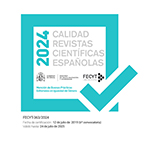Enfoque interseccional en un protocolo para el análisis de la cobertura periodística de feminicidios
Resumen
Introducción y objetivo. El artículo parte del supuesto de que la violencia contra las mujeres -que puede derivar en feminicídios- es un problema público que requiere que las políticas de Estado sean pensadas desde una óptica interseccional (Crenshaw, 2004; Collins y Bilge, 2021). Desde esta perspectiva, nuestro objetivo es comunicar un protocolo de cubrimiento periodístico de feminicidios. Metodología. A partir de lecturas teóricas y empíricas sobre el feminicidio y los estudios de género desde una perspectiva interseccional, proponemos un protocolo de análisis del cubrimiento de los feminicidios, compuesto por siete ejes de lectura. Seis de ellos están relacionados con crímenes específicos reportados por la prensa y pretenden identificar información sobre: (1) el medio, la materialidad y la localización; (2) el crímen; (3) la víctima; (4) el agresor; (5) las fuentes de información; y (6) la estratificación sexual. El séptimo eje se refiere a la lectura de (7) noticias generales, no relacionadas a casos específicos, pero que abordan el tema del feminicidio, cuestionando aspectos que cruzan los otros ejes, principalmente si la violencia contra las mujeres es discutida como un problema público y si hay elementos identificables de marcadores interseccionales. Resultados y conclusiones. El análisis permite percibir la utilidad del protocolo en la búsqueda de marcadores sociales interseccionales. El protocolo permite analizar los límites del cubrimiento periodistico con respecto a la superposición de violencia y opresión en los casos de feminicidio. Al mismo tiempo, permite ver aspectos potencialmente relevantes para un tratamiento más adecuado del tema por parte de la prensa.
Descargas
Descarga artículo
Licencia
La revista Investigaciones Feministas, para fomentar el intercambio global del conocimiento, facilita el acceso sin restricciones a sus contenidos desde el momento de su publicación en la presente edición electrónica, y por eso es una revista de acceso abierto. Los originales publicados en esta revista son propiedad de la Universidad Complutense de Madrid y es obligatorio citar su procedencia en cualquier reproducción total o parcial. Todos los contenidos se distribuyen bajo una licencia de uso y distribución Creative Commons Reconocimiento 4.0 (CC BY 4.0). Esta circunstancia ha de hacerse constar expresamente de esta forma cuando sea necesario. Puede consultar la versión informativa y el texto legal de la licencia.











